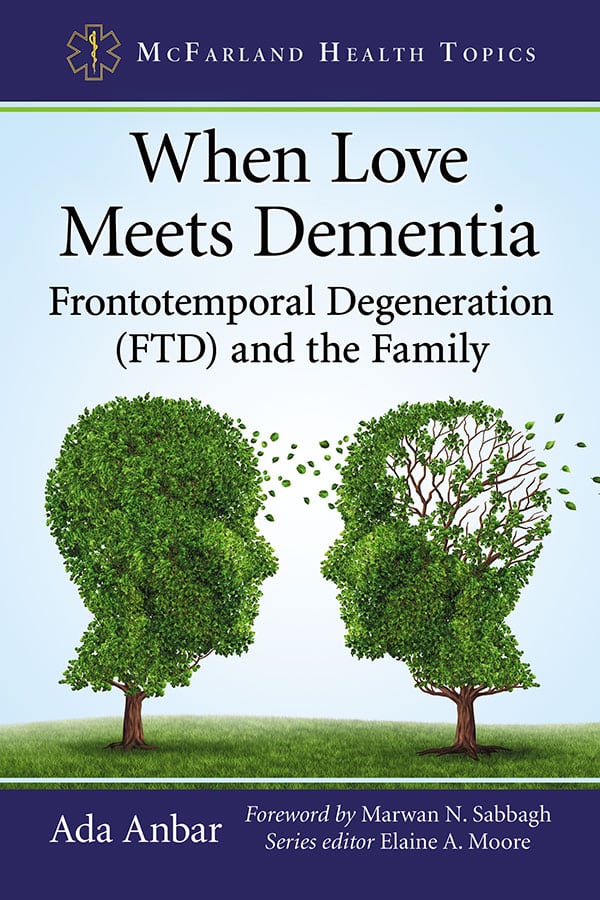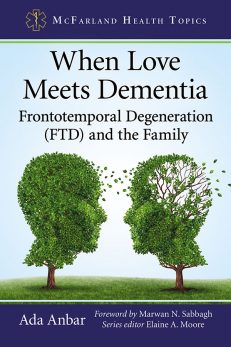When Love Meets Dementia
Frontotemporal Degeneration (FTD) and the Family
$29.95
In stock
About the Book
Frontotemporal Degeneration (FTD) is now recognized as one of the most common forms of dementia in individuals under age 65, second only to Alzheimer’s. Shedding light on a little known brain disease, this volume examines FTD from a few angles, beginning with the author’s insightful memoir of her husband’s struggle with FTD and its impact on their family. Detailed background information on the disease is provided along with discussion of related issues, and information on how to minimize the chances of becoming a victim.
About the Author(s)
Bibliographic Details
Ada Anbar
Series Editor Elaine A. Moore
Foreword by Marwan N. Sabbagh
Format: softcover (6 x 9)
Pages: 210
Bibliographic Info: 12 photos, notes, bibliography, index
Copyright Date: 2019
pISBN: 978-1-4766-7340-0
eISBN: 978-1-4766-3376-3
Imprint: McFarland
Series: McFarland Health Topics
Table of Contents
Acknowledgments xiii
Foreword by Marwan N. Sabbagh MD, FAAN 1
Preface 3
Introduction 5
Part I: The Personal Story—Sixty Years of Marriage, Then Kicked Out
1 • The Day That Changed My Life 10
A Cruise to the Baltic 11
2 • A Fractured Spine 14
The Long Flight Home 15
A Stay in the Hospital 16
3 • The CNAs Are Coming Home 19
Fountain Hills 21
A Bad Idea 25
The Suicide Threats 27
4 • Romantic Beginnings 31
A Personal Security Guard 34
The Lawyers Are Stepping In 36
5 • Kicked Out of My Grave 40
The Need for a Medical Evaluation 41
6 • The Apartment 43
The Missing Gold Coins 45
Life After the Crash 46
Sunday Visits to Fountain Hills 49
Part II: The Elusive Diagnosis
7 • An Emerging Pattern 54
The Chronology of a Disease 54
A New Homecare Agency 59
The Race for a New Psychiatric Evaluation 61
A Tragicomic Scene 62
8 • At Last a Diagnosis 64
Difficult Decision 65
The Silver Lining 67
9 • Crossing Over 69
Part III: Lingering Questions
10 • What Exactly Is FTD? 74
Is FTD Common? 76
Is FTD a New Disease? 77
How FTD Got Its Name 79
The Importance of Scientific Conferences 82
Diagnostic Criteria 84
11 • Sub-Types of FTD 85
Prognosis 86
Warning Signs 86
12 • The Clinical Symptoms of FTD 88
FTD vs. Alzheimer’s 89
What Causes FTD? 91
13 • Triggers for FTD Development 93
The Role of Genetics 93
The Pros and Cons of Genetic Testing 95
Other Possible Factors 97
Part IV: Treatment/Prevention/Management
14 • Basic Pre-Treatment Information 106
Before Treatment Begins 106
15 • Common Pharmacological Treatments 108
16 • Non-Pharmacological and Nutritional Support 110
Supplements 113
The Healthy Brain Diet 114
17 • The Healthy Lifestyle 116
Keeping Active 116
The Importance of Sleep 117
A Good Bedtime Routine 118
Manage Your Stress 119
Stop Smoking and Drinking 120
18 • Rehabilitation 122
The Rehabilitation Team 122
The Danger of Deconditioning 123
Pressure Sores 124
Assistive Devices 126
19 • The Supportive Environment 127
A Sense of Calm and Reassurance 128
Minimizing Fall Risks 129
General Environmental Safety Issues 130
FTD and Driving 131
Part V: When FTD Is Suspected
20 • What to Do When FTD Is Suspected 134
Confirm the Diagnosis 134
Convene a Family Meeting 135
Create a Care Team 137
Legal Issues 138
Money Matters 139
Conclusion 141
21 • The Altered Relationship 142
Loss of Insight and Self-Awareness 143
Loss of Empathy 144
Apathy and Social Withdrawal 145
Socially Inappropriate Behavior 146
Gone but Not Gone 147
22 • The Care of the Caregiver 148
The Job of the Primary Caregiver 148
Helpful Recommendations for the Primary Caregiver 150
23 • Caregiver Resources 153
Community Services 153
The Silverado Story (Model I) 157
Dementia Village (Model II) 161
24 • Is Dementia a Normal Part of Aging or a Disease? 163
The Story of the Super-Centenarians 164
The Blue Zone Areas 165
The Effect of Our Changing Demographics 167
Conclusion 169
25 • The Future of FTD Research 171
Slow Progress but Much Hope 171
More Genetic Research 172
A Search for the Process 172
Are Rates of Dementia Falling? 174
The Bredesen Protocol 175
Autopsy Research 176
Famous People Who Suffered from Dementia 177
26 • Personal Reflections 179
Chapter Notes 181
Resources 187
Recommended Reading 189
Bibliography 191
Index 195
Ebook Availability
Amazon Kindle
Apple
B&N Nook
eBooks.com
Google Play
Kobo
Walmart






